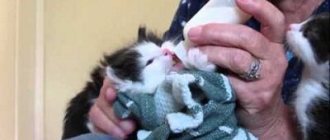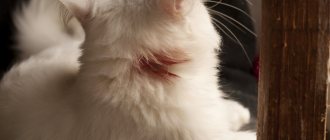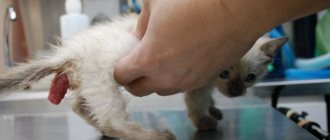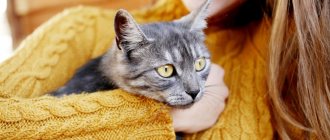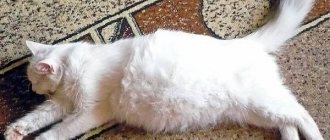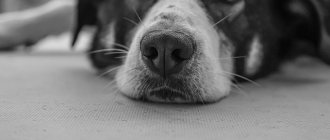Causes
The main reason that causes colitis in cats is poor nutrition. Low-quality, rotten, low-quality products, food from “your own table” do not contribute to the improvement of the gastrointestinal tract. Poisonous toxins, which are a product of food breakdown, irritate the mucous membranes.
This creates a favorable environment for the development and activity of pathogenic bacteria. The large intestine reacts to this phenomenon with increased peristalsis, diarrhea, vomiting and other symptoms characteristic of colitis.
Other factors that provoke the development of the disease include:
- contaminated or raw tap water;
- hot or cold food;
- consumption of products unnatural for animals (sweets, pasta, etc.);
- helminth infection;
- pathologies of infectious and non-infectious nature;
- dysbacteriosis;
- allergy;
- metabolic disease;
- accidentally swallowed foreign objects, including fur, stuck in the colon;
- eaten rodents;
- intestinal injuries (tubular bones consumed as food may well cause mechanical damage to the gastrointestinal tract).
Finally, colitis often develops against the background of stress associated with a change of place of residence, the appearance of another pet in the house, etc.
How does this disease manifest itself?
The main complaint that manifests itself first and with which the owners turn to the veterinarian is colonic diarrhea.
Owners will be struck by an undecorated stool in a tray, which has an unusually foul odor for a pet’s feces. If you look closely, you will see an uncharacteristically large amount of mucus in the stool and traces of blood.
If the cat is affectionate and is often close to the owner, the owner of the animal may hear a strange rumbling in the cat’s stomach. When you try to touch the belly of your favorite animal, it will be swollen, dense, and painful.
Reference!
Despite all the horrors of the disease, the cat eats as usual.
If the purring family member is not treated in time, a vicious circle occurs.
Constant diarrhea leads to a lack of fluid, vitamins and fats in the cat's body. Since the rest of the digestive system is working well, the cat tries to make up for the deficiency. She eats larger portions than usual. But in the intestines, absorption is still impaired. An increased amount of food causes more and more diarrhea, and more and more diarrhea, in turn, causes an increase in food. This is how a vicious pathological circle is formed with colitis in cats.
When the disease is left untreated for a long time, the cat begins to rapidly lose weight. This condition can lead to complete exhaustion and even death of the animal. Therefore, it is better to start treatment as quickly as possible, so that the only problem the cat suffers from is diarrhea.
Reference!
The cat may also be bothered by vomiting. This is a symptom uncharacteristic of colitis, but occurs periodically with this disease.
Symptoms
Acute colitis is characterized by a clear clinical picture. The first symptoms may appear within a couple of hours after the action of the provoking factor. The cat does not show activity, hides from the owner, does not respond to calls, and lies down most of the time. There is no appetite, vomiting may occur.
As the disease progresses, the animal's temperature rises, convulsions appear, and the mucous membranes turn blue. Characteristic symptoms are a dirty white coating on the tongue, a rotten smell from the mouth.
The stool is liquid, glassy, mixed with blood and pus. Defecation is frequent, and you can see that the sphincter is in a relaxed state, and the posterior rectum is gaping.
The cat's belly is inflated like a drum. When you press on it, even from a distance, bubbling, seething sounds can be heard. The animal experiences severe pain upon examination.
The chronic stage of colitis is practically asymptomatic. Only stool that smells bad and has a non-specific color of stool can cause anxiety.
Spastic colitis in cats (irritable bowel syndrome)
Home / Diseases of cats / Spastic colitis in cats (irritable bowel syndrome)
The most common signs of colitis and proctitis in cats is a bowel movement disorder, which is manifested by chronic diarrhea, often mixed with blood. Therefore, diarrhea is one of the main reasons why cat owners contact a veterinarian. Chronic diarrhea represents a difficult diagnostic problem. Most likely, this is due to the wide variety of diseases in the range of differential diagnosis. The main causes of such diseases are endoparasites, enteropathies, intestinal dysbiosis, idiopathic intestinal diseases, intestinal lymphomas, bacteria, protozoan invasion, allergic factors, etc. Defecation, compared to small intestinal diarrhea, can be frequent, in small portions, stools are unformed, liquid.
In such diseases, anamnesis is extremely important. Owners of their pets are not always inclined to tell plausible stories from the lives of their pets, or they lose sight of past illnesses. Therefore, it remains important to obtain a complete nutritional history and a systematic approach for the most accurate diagnosis. Endoparasitic pathologies are to some extent easier to diagnose and treat, but they should not be excluded. Regardless of the results of the study, a broad-spectrum anthelmintic drug is prescribed.
Clinical case.
Clinical signs of diarrhea that appears periodically. An admixture of blood and mucus appears in the stool, which, in principle, alarms the owners. This might not have happened before. Sometimes defecation is accompanied by cramping pain in the lower abdomen. Pain also appeared during the act of defecation, flatulence was observed, and sometimes vomiting occurred. Hairballs can also be found in the vomit, sometimes in quite large quantities. In this case, the general condition and behavior of the animal changes only during the period of diarrhea. The animal becomes apathetic, lethargic, and sleeps most of the day. A physical examination does not always reveal abnormalities, only minor discomfort upon deep palpation.
For additional diagnostics, ultrasound diagnostics of the intestines and a clinical blood test were prescribed. Clinical blood tests are often within normal limits. According to the results of ultrasound, it is important to exclude foreign bodies and other space-occupying formations, the contents in the colon are predominantly weakly echo-dense (pasty) with gases, visible areas of the wall in the colon can be enlarged while maintaining the differentiation of the layers, in the cecum the wall is thickened, l / without features.
In the first days, treatment is carried out on an outpatient basis, then owners can perform many manipulations at home and come to the appointment at the time prescribed by the doctor to correct the treatment regimen. A treatment regimen should be discussed with the owners, the possibility of a protracted course of the disease and the need to exclude all stress factors, and strict adherence to the diet should be informed.
Drug therapy:
* Drugs that regulate intestinal motility - loperamide 0.1 mg/kg orally 3 times a day for the first 1-2 days
* You can use smectite (dioctahedral smectite) as an adsorbent, in an approximate dosage of 1 sachet 3 times a day for 2-3 days.
* The first-line antibiotic is prescribed tylosin 25 mg/kg every 12 hours for a period of 6-8 weeks with constant adjustment of the treatment regimen and dose.
* The second-line antimicrobial drug is prescribed metronidazole at a dose of 10 mg/kg every 12 hours for a period of 4 weeks with adjustment of the treatment regimen and dose.
* To normalize the intestinal microflora and create favorable conditions for digestion, improve feed conversion, probiotics (emprobio) are prescribed daily in a dose of 2 ml once a day.
* Milbemax for cats is prescribed as a repeat deworming drug.
As a dietary therapy, low-fat foods with a high degree of digestibility are prescribed, ensuring high digestibility and minimizing the food load on the damaged intestine. In addition, the feed should include coconut oil, which is high in medium-chain fatty acids, providing an easily digestible and absorbable source of energy. The presence of short-chain fatty acids for enterocytes is also important when following dietary feeding. The feed should promote the formation of good quality fecal matter, which is achieved by an increased mixture of soluble and soluble fiber. All these characteristics and advantages are contained in Purina Veterinary Diets EN (gastroenteric), Hills i/d, Roayl Canin gastro intestinal Dietary feeding is prescribed in a dose corresponding to the weight of the animal.
The main principles in the treatment of irritable bowel syndrome are strict adherence to diet and timely administration of medications. Intestinal peristaltic modifiers may also be beneficial, and dietary prebiotics and supplemental probiotics may also be indicated. Diet therapy is very important for diseases of the large intestine, and can be used either independently or in combination with drug treatment during the period of exacerbation of the underlying disease. Diet therapy provides high digestibility with a reduced fat content and reduces irritation in the large intestine, promotes the formation of healthy microflora, and optimizes digestibility and absorption of nutrients. Despite the fact that the food is a diet, it satisfies the specific needs of the cat and meets the increased requirements for gastrointestinal diseases.
Nefedeva Lyudmila Vladimirovna
Veterinary clinic "Panda"
Kazan
Colitis in cats symptoms
Diagnostic methods
Diagnosis of colitis consists of differentiating it from other diseases of the gastrointestinal tract with similar symptoms. To make a diagnosis, the veterinarian, in addition to a visual examination and medical history, needs to conduct a number of diagnostic studies:
- scatological analysis of stool;
- colonoscopy;
- biopsy;
- general and clinical blood tests;
- barium enema followed by an x-ray of the colon.
After determining the diagnosis, the specialist prescribes appropriate treatment.
What is colitis and how does it threaten the animal?
Inflammation of the mucous membranes of the colon is caused by various reasons, but equally leads to extremely unpleasant consequences. Colitis in cats causes problems with proper digestion, caused by problems with the absorption of fluid in the intestines.
As a result, this causes either constipation or intestinal upset, which negatively affects the normal digestive process. This one failure can “pull” a whole chain of nutritional disorders, which can cause very dangerous processes in the animal’s body.
We suggest you read: The main symptoms and signs of worms in cats
Without treatment, colitis leads to ulceration of the mucous membrane, the appearance of purulent lesions, and the development of cancer. The longer the disease lasts, the higher the risk of complications, severe weakening of the cat and death.
Treatment, prognosis
With timely treatment, the prognosis is favorable. The course of therapy lasts 5-7 days. It consists of three stages: restoring water-salt balance, stabilizing stool, and relieving symptoms of intoxication.
To remove toxins, adsorbents are prescribed - activated carbon, white clay, Smecta. Using an enema, the intestines are washed out or a drug based on sodium sulfate is given (one time).
To restore water balance, rehydration therapy is necessary by orally administering Ringer's solution (alternatively, a weak solution of table salt) or injecting saline with glucose.
In case of bacterial infection, the use of antibiotics (Tylosin) and antiprotozoal drugs (Metronidazole, Furazolidone) is indicated.
For the allergic nature of colitis, corticosteroids (Prednisolone) are prescribed, and for the chronic form, anti-inflammatory drugs (Azathioprine, Sulfasalazine). To restore normal intestinal microflora, probiotics are needed (Pro-Kolin, Lactobifid, Lactoferon).
Preventive actions
Sometimes owners become the cause of their pet's illnesses - through an oversight, due to neglect of basic hygiene, or, oddly enough, due to an excess of love. In the latter case, the disease can be provoked by feeding the cat from the owner's table.
Some animals beg for a handout so diligently and tenderly that the hearts of the owners cannot stand it, and they give the purr a treat, believing that human food will not harm it. But most often cats ask for exactly what is categorically unacceptable to them, for example, smoked sausage or fish, fried meat. Some people love spicy cheese, butter, there are even connoisseurs of pickled cucumbers, rich borscht or sweets.
In microdoses, such indulgence can still be tolerated occasionally, but regular feeding of “human” food can quickly lead to digestive disorders and cause colitis. To prevent this from happening, cats can only be given properly selected, balanced food for animals of their age, preferably chosen by a veterinarian.
The second aspect is the environment in the house. Dirty bowls, lack of clean drinking water, irregular use of anthelmintics and stress can cause the development of colitis. Avoiding this is quite simple - just regularly expel parasites, keep the cat's bowls and trays clean, especially if there are several cats in the house, change drinking water every day and do not give it untreated or unboiled.
It is highly advisable to have your pet examined at least once every six months in a good veterinary clinic. And of course, if signs of illness appear, do not self-medicate, but take the mustachioed handsome man to an experienced doctor.
What to do at home
The owner must follow the veterinarian's instructions. Self-medication can aggravate the situation and worsen the cat's condition. You can use decoctions of medicinal herbs (chamomile, plantain), which have antiseptic and anti-inflammatory properties. However, they should not completely replace traditional treatment.
Great importance is paid to the nutrition of the animal. Your pet should receive balanced, high-quality food that promotes intestinal restoration (Sensitive, Royal Canine GastroIntestinal).
How to prevent the occurrence of colitis?
As you know, it is better to prevent a disease than to treat it later. This statement also applies to colitis. The following simple rules will help prevent the disease:
- The cat's nutrition must be correct and balanced. It is best if it is premium industrial food (Royal Canin, Purina Pro Plan and others);
- The diet should have enough fiber;
- You should not feed your cat lard. It's better to give her turkey meat;
- There is no need to give your cat antibiotics every time the animal sneezes;
- It is necessary to conduct examinations with a veterinarian once a year for preventive purposes. For older cats (over 12 years old) – once every 6 months.
Types of disease
Experts identify three separate classification groups that allow you to determine the type of colitis. They are divided according to the origin, course of the disease and where the source of inflammation is localized. Let's look at each group in more detail.
By flow:
- Chronic. It is characterized by extensive damage to the digestive tract, long treatment and frequent relapses.
- Spicy. Inflammation of the large intestine, which occurs spontaneously and does not last very long. It can occur in a kitten due to the harmful effects of parasites and intolerance to dairy products. In an adult cat - due to eating a dead mouse, spoiled food and toxic substances.
By origin:
- Viral. An infection enters the intestines, causing an inflammatory process.
- Toxic. The animal eats poison or chemicals that cause poisoning.
- Ulcerative. Due to the development of ulcers inside the digestive tract.
- Ischemic. The pathology occurs against the background of inflammation of the pet's abdominal aorta.
- Bacterial. Bacteria that enter the colon, such as salmonella or yersinia, provoke pathological reactions.
According to the location of the inflammatory focus:
- Proctitis is an inflammatory process on the rectal mucosa.
- Typhlitis - occurs due to irritation of the mucous membrane of the cecum.
- Pancolitis is an extensive lesion of the entire large intestine of a pet.
According to statistics, acute or chronic pancolitis is the most common among cats, leading to constant diarrhea and general weakness.
Prevention
We have already found out what colitis is in cats. The symptoms and treatment have been discussed in detail above. Now let's talk about preventive measures. These include the following:
- Lack of stress in the animal's life.
- Proper nutrition. Use only high quality feed. If you plan to feed “natural”, then create a balanced diet. Add vegetables and offal to it. Don't change what I'm used to. A sudden change in diet leads to various intestinal disorders. The animal must have regular access to water.
- It is imperative that the animal undergo timely deworming and vaccination.
- Don't forget about a routine check-up with your veterinarian.
Here's how to prevent colitis in cats. The above recommendations will help your pet stay healthy and strong. This way you can reduce the chances of such a disease occurring.
Now you know what colitis is in cats. Symptoms and treatment of this disease are two topics that we discussed in detail in our article. We also provided useful recommendations for the prevention of this disease in cats.
Animals have a similar digestive system structure to humans, and therefore their digestive system diseases are identical to ours. One of the most common pathologies of the gastrointestinal tract is colitis.
